Freeze Frame: Tracking Jamal Murray
Posted by Brian Joyce on March 3rd, 2016Jamal Murray had quite the month of February. The Kentucky freshman scored at least 20 points in eight consecutive outings and averaged an insane 26.4 points per game over that stretch, giving him the highest scoring average by a Wildcat for a month since Jodie Meeks torched opponents in January 2009 for 28.0 PPG. Murray’s tear through conference play included a 35-point performance against Florida on February 6, and a 33-point effort at Vanderbilt on February 27.
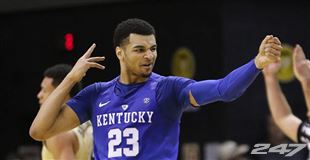
Murray hits his target more often than not (247 sports).
While Murray has been especially hot over the past month, he has been impressive all season. His scoring average of 19.9 PPG ranks third in the SEC and second in the country among freshman. If it holds, he would set a new school freshman record and would represent the highest for any player under head coach John Calipari at Kentucky. And it seems that he is picking up where he left off in March, notching 21 more points against Florida on Tuesday night. In this edition of Freeze Frame, we analyze how Murray freed himself up for open shots against the Gators earlier this week.
Murray is especially deadly in transition, making two of his four three-pointers against Florida on a fast break. According to hoop-math.com, a little over 25 percent of Kentucky’s initial shot attempts occur in transition. Murray typically fades to the corner while the ball-handler, usually point guard Tyler Ulis (but sometimes fellow guard Isaiah Briscoe), advance the ball. Ulis or Briscoe drives toward the middle of the lane, which normally draws defenders in a fast break scenario. That leaves Murray alone to patiently wait for the wide-open dagger. You can see just how open he is in both of the below frames.
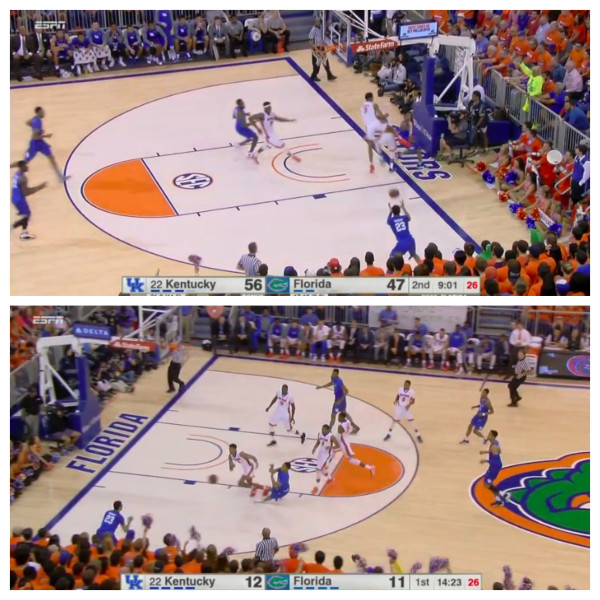
Murray runs directly to the corner, and Florida fails to find him.
Murray is active in the half-court as well, moving baseline to baseline through screens without the ball. In the next frame, you can see that Briscoe pops out to receive the ball, opening up a spot for Murray to find a shot.
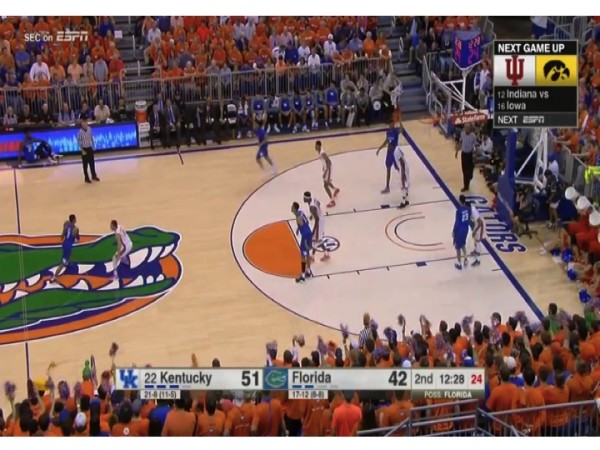
Murray lines up just outside the paint on the baseline.
Marcus Lee sets the down screen and Murray runs his defender, Kasey Hill, off of the pick.
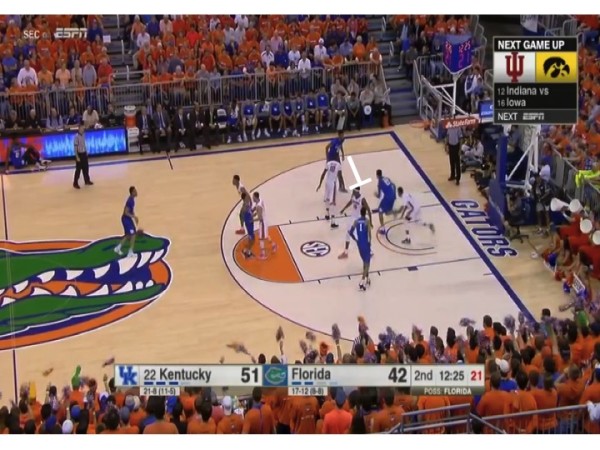
Murray running Hill around.
Nothing is available on that option, so Murray looks to reverse the play, this time running Hill through two more screens. Lee pops back out to screen Hill and then Skal Labissiere lines up to set the double-screen for him on the other side. Murray is looking to establish one of two options on this baseline run. First, he can pop out to that giant rectangle and shoot an open three, like he did several times against Vanderbilt last week. Or, if the defender closes out on the shot like Hill does in this play, Murray has the option of beginning the two-man game with the big guy inside.
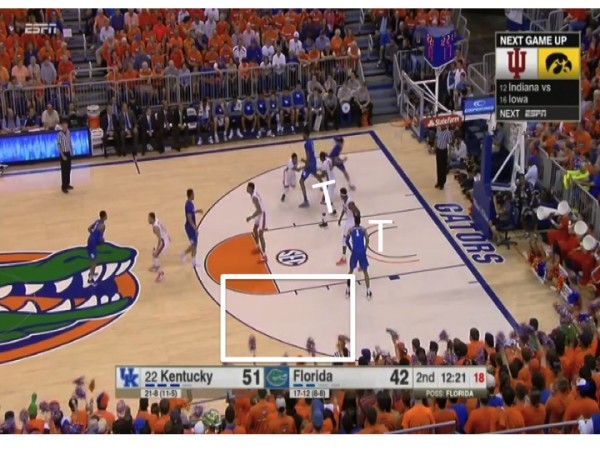
Hill stays with Murray through two screens.
Hill plays great defense, sticking with Murray and making the pass difficult to receive. Because of Hill’s denial defense, Murray is forced to extend toward the top of the key and reset the offense. Labissiere pops back out to the three-point arc to set a screen as Ulis fades to the corner. Murray can then run a pick-and-pop with Labissiere or penetrate into the lane for a mid-range jumper or attack the basket. The two-man game between Murray and Labissiere worked well against Florida because opponents are respecting Murray’s shot, especially given his recent hot streak, but Labissiere has a nice mid-range shot that cannot be ignored.
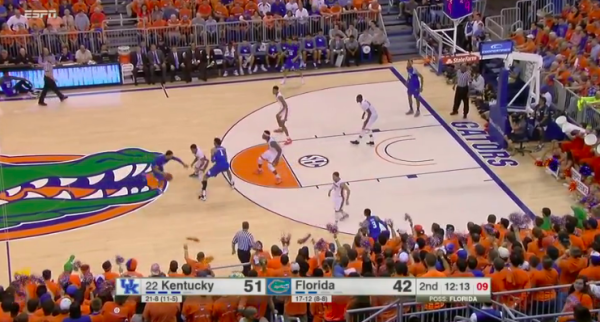
The two man game between Labissiere and Murray.
Murray’s other go-to move in the half-court begins stationed in the corner. He runs through a double-screen from the Horns set where the four and five line up at the elbows. In this play, Alex Poythress sets the initial screen for Murray out of the corner, while Briscoe runs the baseline to replace Murray’s spot.
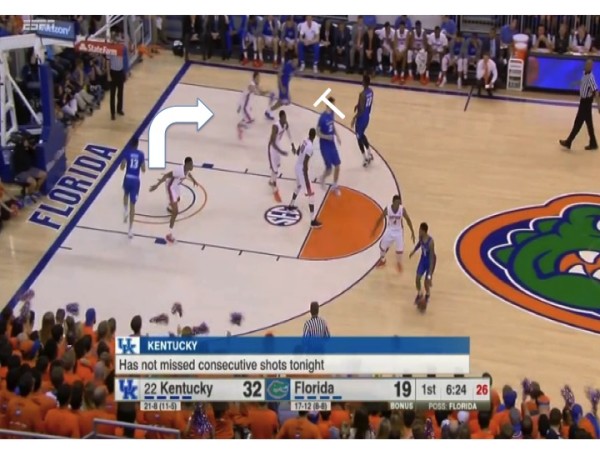
Murray comes around the first screen.
Isaac Humphries then slides over to set a double-screen for Murray’s defender.
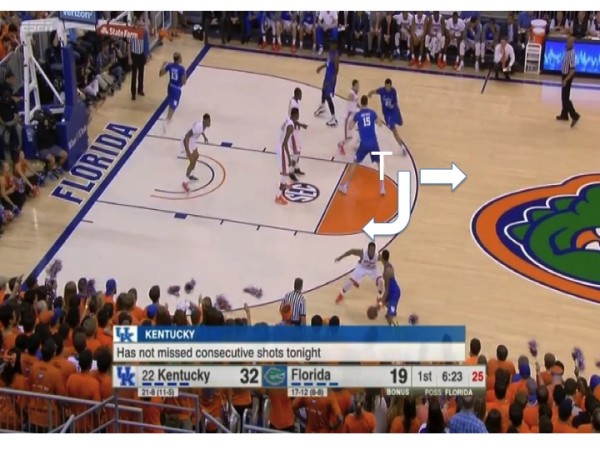
Murray has two options coming out of the second screen.
Briscoe maintains good floor spacing in the Wildcats’ attack. His replacement also leaves a huge hole on the near side of the court, giving Murray two options coming off the second screen. Murray can keep moving toward Ulis, utilizing the space provided by Briscoe to find an open mid-range shot or post opportunity, or he can pop out to the top of the key for an open three or a dribble-drive opportunity. The top of the key option also frees Humphries to screen Murray’s defender again, allowing the scorer to drive right and potentially find Briscoe for an open jumper. Briscoe’s emergence as a capable mid-range shooter is key for this reason, as Kentucky looks to the corners for open shooters on penetration.
The increased focus on screening action from Kentucky’s bigs looks like it may very well be the minor tweak used by Calipari in this game. The additional picks set to free Kentucky’s guards has benefitted Murray in finding open looks. The Wildcats managed 1.18 points per possession against a Florida team that ranks 31st in adjusted defensive efficiency, according to KenPom, and Murray doesn’t appear to be slowing down any time soon. While another more celebrated SEC freshman leads his team through the NIT this month, Murray will be the primary scoring option for a team passing through the rigors of the NCAA Tournament. If Murray stays as hot as he has been over the last month-plus, Kentucky could be sticking around for a while longer than many pundits expected.












































